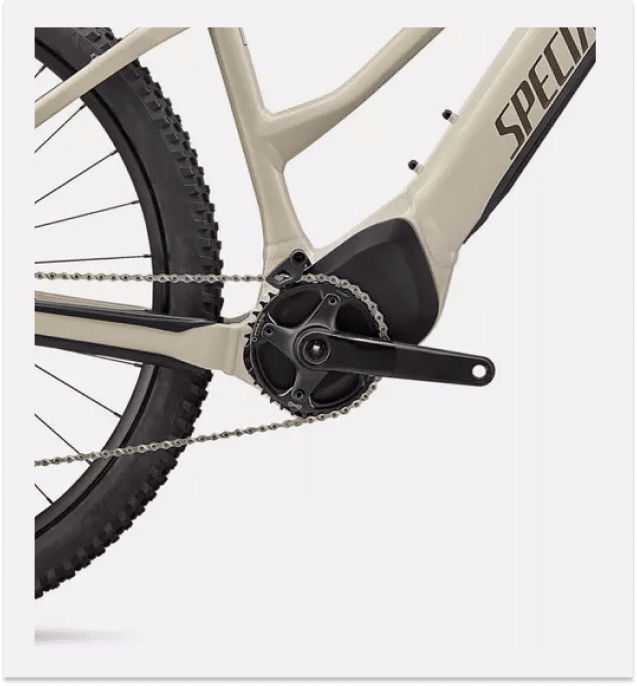Hearing a clicking noise while pedaling can be annoying. It might signal an issue with your bike.
A smooth, quiet ride is what every cyclist desires. Yet, sometimes strange sounds disrupt this peace. One common issue is a clicking noise when pedaling. This sound can range from a slight tick to a loud clack. It might be a small problem or something bigger.
Understanding the cause of Bike Making Clicking Noise When Pedaling is key. Whether it’s loose parts, worn components, or simple adjustments, knowing the source helps fix it quickly. This guide will help you identify and solve the clicking noise. Let’s get back to enjoying those smooth, silent rides.

Credit: www.reddit.com
Common Causes Of Clicking Noises
Experiencing a clicking noise while pedaling can be frustrating. There are several common causes for this noise. Understanding these causes can help you fix the issue and enjoy a smooth ride.
Loose Components
Loose parts often cause clicking noises. The most common culprits include:
- Pedals: Check if they are tightly secured to the crank arms.
- Crank Arms: Ensure they are firmly attached to the bottom bracket.
- Bolts and Screws: Inspect all bolts and screws on your bike. Tighten as needed.
Worn Out Bearings
Bearings play a crucial role in smooth bike operation. Worn out bearings can cause clicking noises. Key areas to inspect include:
| Component | Location |
|---|---|
| Bottom Bracket | Between the crank arms |
| Hub Bearings | Inside the wheel hubs |
| Pedal Bearings | Inside the pedals |
Chain Issues
The chain is a vital part of your bike. Chain issues can lead to clicking noises. Common chain-related problems include:
- Chain Wear: A worn-out chain can skip and cause noise.
- Chain Tension: A loose chain can slap against other components.
- Chain Lubrication: Ensure the chain is well-lubricated.
Regular maintenance of your chain can prevent these issues. Keep it clean and lubricated.

Credit: ebikecommuting.com
Diagnosing The Noise
A clicking noise when pedaling can be annoying. It can also be a sign of a deeper issue. Diagnosing the noise is the first step to fixing it. This section will guide you through different methods to identify the cause of the clicking sound.
Listening Techniques
Start by listening carefully to the noise. Pedal slowly and try to pinpoint the sound’s origin. Is it coming from the pedals, crank, or chain? Pay attention to the rhythm of the click. Does it occur with every pedal stroke or randomly? These clues can help narrow down the problem.
Bike Stand Method
Use a bike stand for a better inspection. Lift the bike off the ground and secure it. Spin the pedals and listen for the clicking noise. This method allows you to isolate the sound without road noise. Check the pedals, crank, and chain for any visible issues. Make sure all bolts and screws are tight.
Ride Testing
Take your bike for a test ride. Ride on a flat surface and listen carefully. Try different gears to see if the noise changes. Stand up while pedaling to determine if the noise persists. This can help identify if the noise is related to your riding position. Make mental notes of any changes in the noise.
Fixing Loose Components
Experiencing a clicking noise while pedaling can be frustrating. Often, this sound originates from loose components on your bike. Fixing these loose parts can ensure a smoother and quieter ride. Let’s explore how to address common areas where looseness can develop.
Tightening Bolts
Loose bolts are a common cause of noises. Regularly check all bolts on your bike. Use a torque wrench to ensure bolts are tightened to the manufacturer’s specifications. Pay special attention to:
- Chainring bolts
- Seat post clamp
- Handlebar stem
Properly tightened bolts maintain bike integrity and reduce noise.
Securing Pedals
Pedals can become loose over time. To check, use a pedal wrench. Turn the pedals clockwise to tighten. Ensure the threads are clean and apply a bit of grease. This prevents rust and makes future adjustments easier. If pedals are still noisy, consider:
- Inspecting the pedal bearings
- Replacing worn pedals
Secure pedals contribute to a smoother ride.
Adjusting Crank Arms
Loose crank arms can produce a clicking noise. Use an Allen wrench to tighten the bolts securing the crank arms. Check if the crank arms wiggle. If they do, it’s a sign they need tightening. Follow these steps:
- Remove the crank arm bolt
- Apply a bit of grease to the bolt
- Re-insert and tighten the bolt
Regular checks on crank arms ensure they stay secure and functional.

Credit: www.youtube.com
Addressing Bearing Problems
Bearing issues can cause your bike to make a clicking noise while pedaling. Bearings are crucial for smooth bike operation. They reduce friction and allow your bike to move easily. Addressing bearing problems can save you from further damage and ensure a smooth ride. Let’s explore how to inspect, replace, and lubricate bearings effectively.
Inspecting Bearings
First, check the bearings for any signs of wear or damage. You need to remove the wheel or crankset to access them. Look for the following:
- Rust or corrosion
- Loose or missing balls
- Cracked or broken bearing races
Spin the wheel or crankset by hand. Listen for unusual noises. If you hear grinding or clicking, your bearings may be the culprit. Also, check for play or wobble in the wheel or crankset. Excessive movement indicates worn bearings.
Replacing Bearings
If bearings are damaged, replacement is necessary. Follow these steps:
- Remove the old bearings using a bearing puller or a similar tool.
- Clean the bearing cups or races thoroughly.
- Press in the new bearings carefully, ensuring they are seated properly.
Replacing bearings can restore smooth operation to your bike. Ensure you use the correct size and type of bearings for your bike model.
Lubricating Bearings
Lubrication is essential for bearing longevity and smooth performance. Follow these steps to lubricate your bike’s bearings:
- Remove any dirt or old grease from the bearings.
- Apply a small amount of high-quality bearing grease.
- Ensure the grease is evenly distributed around the bearings.
Lubricated bearings reduce friction and prevent wear. Regular lubrication helps maintain a quiet and efficient ride.
Proper bearing care ensures your bike remains in top condition. Inspect, replace, and lubricate bearings as needed.
Chain Maintenance Tips
Maintaining your bike chain is essential for a smooth ride. A well-maintained chain reduces noise and improves performance. Here are some tips to keep your chain in top condition.
Cleaning The Chain
Regular cleaning keeps dirt and grime away. Use a chain cleaner and a brush. Rotate the pedals to clean the entire chain. Wipe off excess cleaner with a cloth. This prevents build-up, which causes clicking noises.
Lubricating The Chain
A clean chain needs proper lubrication. Use a bike-specific lubricant. Apply it evenly on the chain links. Turn the pedals to spread the lubricant. Wipe away any excess. This ensures smooth movement and reduces noise.
Checking Chain Tension
Loose chains can cause clicking sounds. Check the tension regularly. The chain should have minimal slack. Adjust the tension if needed. Proper tension keeps your ride smooth and quiet.
When To Replace Components
Hearing a clicking noise while pedaling can be quite annoying. It may signal the need to replace some bike components. Identifying the exact part causing the noise is crucial. This process ensures that you maintain a smooth and quiet ride.
Identifying Wear
Start by examining the chain. A worn chain often causes clicking noises. Use a chain checker tool to measure the wear. If the chain has stretched beyond the recommended limit, it’s time for a replacement.
Next, inspect the pedals. Worn-out pedal bearings can create noise. Spin the pedals. If they feel gritty or wobble, they need attention.
Check the bottom bracket. Clicking sounds here are common due to worn bearings. Rotate the crankset. Any roughness or play indicates wear.
Choosing New Parts
Selecting the right components is vital for a smooth ride. For chains, choose a brand that matches your drivetrain specifications. Shimano, SRAM, and KMC offer reliable options.
When replacing pedals, consider the type of riding you do. Clipless pedals are great for road cycling. Flat pedals work well for mountain biking. Brands like Crankbrothers and Shimano provide quality choices.
If you need a new bottom bracket, ensure compatibility with your bike’s frame and crankset. Hollowtech II and SRAM GXP are popular standards.
Installing New Components
After selecting the parts, installation is the next step. Start with the chain. Use a chain tool to remove the old chain. Install the new one, ensuring it runs smoothly over the gears.
Replace the pedals by unscrewing the old ones with a pedal wrench. Grease the threads of the new pedals before screwing them in. Tighten firmly to prevent future noise.
For the bottom bracket, remove the crankset first. Use a bottom bracket tool to unscrew and replace it. Reinstall the crankset and check for any play or noise.
Replacing worn components regularly ensures a quiet and efficient ride. Pay attention to wear signs and act quickly to maintain bike performance.
Preventative Measures
Keeping your bike in good shape can stop clicking noises while pedaling. Regular care and maintenance are key. Follow these steps to help keep your bike quiet and running smoothly.
Regular Inspections
Check your bike often. Look for loose parts. Tighten any bolts or screws. Make sure everything is in the right place. A quick check can catch problems early.
Proper Lubrication
Lubricate your bike regularly. Apply oil to the chain, pedals, and other moving parts. This helps parts move smoothly. It also reduces wear and tear. Use the right type of lubricant for your bike.
Timely Replacements
Replace worn-out parts. Do not wait until they break. Worn parts can cause noise. They can also lead to bigger problems. Check your chain, pedals, and other parts. Replace them when needed.
Professional Help
Hearing a clicking noise while pedaling can be annoying and concerning. Seeking professional help can save you time and ensure your bike is safe. Experts can diagnose and fix the issue, giving you peace of mind.
Finding A Bike Mechanic
Start by finding a trusted bike mechanic in your area. Ask friends for recommendations. Look for online reviews to see what others say. A good mechanic has experience with different bike types. They can quickly identify and fix the clicking noise.
Cost Considerations
Repairs can vary in cost. Basic fixes might be cheap. More complex issues can be expensive. Always ask for an estimate before work begins. This helps you budget and avoid surprises.
Warranty And Repairs
Check if your bike is under warranty. Some warranties cover repair costs. This can save you money. Contact the bike manufacturer for details. They might direct you to an authorized repair center. Ensure you keep all receipts and documents. They are needed for warranty claims.
Frequently Asked Questions
Why Is My Bike Making A Clicking Noise?
A clicking noise when pedaling is often caused by loose components. Check your pedals, chain, and crankset for any issues.
How Do I Fix A Clicking Bike Pedal?
To fix a clicking bike pedal, tighten all bolts and ensure the pedal is properly lubricated. This should resolve the noise.
Can A Loose Chain Cause Clicking Sounds?
Yes, a loose chain can cause clicking sounds when pedaling. Ensure your chain is properly tensioned and lubricated.
What Tools Do I Need To Fix The Clicking Noise?
You typically need a wrench set, lubricants, and a bike repair stand. These tools help identify and fix the issue.
Conclusion
Fixing a clicking noise while pedaling can improve your biking experience. Inspect your bike regularly for loose parts or damage. Tighten bolts and lubricate where necessary. Simple maintenance keeps your bike running smoothly. If the noise persists, consult a professional mechanic.
A well-maintained bike ensures safety and enjoyment on every ride. Happy cycling!

